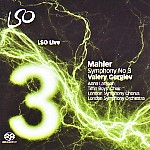This performance starts with a bang, but ends with a whimper. The Mahler Third is admittedly a schizophrenic work, starting with perhaps his most colorful orchestral phantasmagoria (lots of winds, brass, and percussion) and ending with a sublime Adagio in the grand German tradition (meaning heavy on strings). Valery Gergiev and the LSO are great when the music is fast, loud, percussive, glittery, and band-like, and much less successful when it’s not. So the first movement is terrific–excellent work from the horns and solo trombone, no stinting on the vulgarity in the “Southern Storm” episode just before the recapitulation, and a take-no-prisoners coda that’s as skillfully shaped as it is exciting. “At last!” you might think, “Gergiev has finally gotten himself completely together for a whole symphony.” Well, you would be wrong.
The second movement continues the fine impression made by the first: lovely oboe solo and nicely contrasted tempos between sections. The scherzo also features some very characterful winds, but the posthorn episodes are too slow and droopy, the solo is balanced very distantly, and the coda is rushed beyond the capability of the trombones and tam-tam to articulate cleanly. Anna Larsson sings adequately in the fourth movement (she’s making a career of this symphony, appearing also in Abbado’s recent video), but Gergiev’s tempo sounds rushed, the “nature sounds” are uninterestingly matter-of-fact, and the whole thing is both surprisingly rough and deficient in the mysterious atmosphere Mahler requires.
Matters improve once again for the “Bim Bam” fifth movement, with the boys’ choir singing lustily and making an unforgettably vivid impression. The sinister central episode also comes off well, but the finale is a real letdown. It’s not so much that it’s quickly paced, relatively speaking (about 20 minutes); the problem is that tension isn’t well distributed, and the strings cannot sustain the necessary intensity even at this unchallenging speed. Consider the big climax bringing back the material from the first movement: it’s both rushed and underpowered. Note how the strings seem to recede into the background against the brass and timpani, while even those instruments seem anxious to back off Mahler’s extreme dynamics. The soft brass chorale that follows lacks the necessary serene legato phrasing, and the closing pages are simply played too quickly and too crudely (Mahler asks for “noble, full tone”–you can’t call those screaming trumpets “noble”!).
Gergiev is not the most reflective of artists, and this symphony really shows up his inability to deliver the goods in music that requires a healthy measure of sensitivity and architectural control. The sonics, which favor the winds and percussion over the strings, might have something to do with it, but as with so many Gergiev performances you come away feeling that he simply hasn’t lived with the music long enough to play all of it equally well. Some of it interests him more than the rest. That said, the good bits are pretty spectacular, and collectors may well want to hear this release for one of the better first movements in recent memory. For that reason, it earns a qualified recommendation.
































